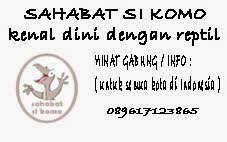T-REC Semarang-komunitas-reptil-semarang-CITES-convention-on-international-trade-in-endangered-species-of-wild-fauna-and-flora-valid
from 12 june 2013-appendix 1-sekilas-tentang-buaya-air-asin- saltwater
crocodile- saltie-estuarine- Indo-Pacific
crocodile- Crocodylus
porosus
- CITES…………valid from 12June 2013
- CLASS REPTILIA ( REPTILES )
- FAMILY : Crocodylidae
( Crocodiles )
- Crocodylus porosus
- Appendix : 1
-
Note :
Saltwater
crocodile
From
Wikipedia, the free encyclopedia
The saltwater crocodile (Crocodylus porosus),
also known as saltie, estuarine or Indo-Pacific crocodile,
is the largest of all living reptiles, as well as the largest terrestrial
and riparian
predator in
the world.
this crocodile can live in salt water, but usually resides
in mangrove
swamps, estuaries,
deltas,
lagoons, and
lower stretches of rivers
Saltwater crocodiles are more territorial than other crocodilians, and are
less tolerant of their own kind. Most crocodiles are social animals,
sharing basking spots and food. Saltwater crocodiles do not fall into this
category however, especially in the case of adult males of the species. They
are extremely territorial and will fight off any intruders. The adult male will
share his territory with a female.
Conservation status
Because of
its resurgence, the species is considered of least concern for extinction.
Currently, the species is listed in CITES as follows:
- Appendix I (prohibiting all commercial trade in the species or its byproducts): All wild populations except for those of Australia, Indonesia and Papua New Guinea
- Appendix II (commercial trade allowed with export permit; import permits may or may not be required depending on the laws of the importing country): Australia, Indonesia and Papua New Guinea wild populations, plus all worldwide populations bred in captivity for commercial purposes
Class:
|
|
Order:
|
|
Family:
|
|
Genus:
|
|
Species:
|
C. porosus
|
Saltwater
crocodile
From Wikipedia,
the free encyclopedia
buaya air asin (Crocodylus
porosus), juga dikenal sebagai saltie, estuarine
or Indo-Pacific crocodile, merupakan yang terbesar , terestrial dan riparian predator
terbesar .
dapat hidup di air garam, tetapi biasanya berada di rawa-rawa bakau, muara, delta, laguna, dan sungai
Buaya air asin lebih teritorial daripada buaya lainnya, dan kurang toleran dari jenis mereka sendiri. Kebanyakan buaya adalah hewan sosial, berbagi tempat berjemur dan makanan. Bagaimanapun Buaya air asin tidak termasuk dalam kategori ini , terutama dalam kasus jantan dewasa . Mereka sangat teritorial dan akan melawan setiap penyusup. Para jantan dewasa akan berbagi wilayah dengan Se ekor betina.
dapat hidup di air garam, tetapi biasanya berada di rawa-rawa bakau, muara, delta, laguna, dan sungai
Buaya air asin lebih teritorial daripada buaya lainnya, dan kurang toleran dari jenis mereka sendiri. Kebanyakan buaya adalah hewan sosial, berbagi tempat berjemur dan makanan. Bagaimanapun Buaya air asin tidak termasuk dalam kategori ini , terutama dalam kasus jantan dewasa . Mereka sangat teritorial dan akan melawan setiap penyusup. Para jantan dewasa akan berbagi wilayah dengan Se ekor betina.
Status konservasi
spesies ini dianggap paling dekat terhadap kepunahan. Saat ini, spesies yang terdaftar dalam CITES ini, sebagai berikut:
• Lampiran I (melarang semua perdagangan komersial dalam bentuk spesies atau produk sampingan nya): Semua populasi liar kecuali dari Australia, Indonesia dan Papua Nugini
• Lampiran II (perdagangan komersial diperbolehkan dengan izin ekspor, izin impor mungkin atau tidak mungkin diperlukan tergantung pada hukum negara pengimpor): populasi liar Australia, Indonesia dan Papua Nugini , ditambah semua populasi di seluruh dunia yang dibesarkan di penangkaran untuk tujuan komersial
Class:
|
|
Order:
|
|
Family:
|
|
Genus:
|
|
Species:
|
C. porosus
|
sumber















